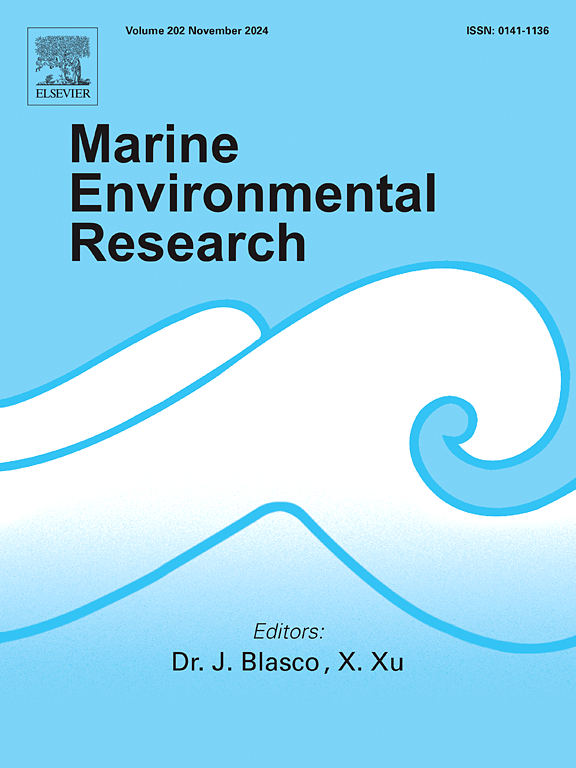鲐鱼(Scomber japonicus)在El Niño和La Niña条件下的适应性:体况、摄食和污染物分析
IF 3
3区 环境科学与生态学
Q2 ENVIRONMENTAL SCIENCES
引用次数: 0
摘要
本研究分析了El Niño和La Niña现象对鲐鱼生理生态和汞污染水平的影响,使用了2021年(La Niña年)和2023年(El Niño年)在西北太平洋地区采集的样本。我们分析了不同体型(100-300毫米)个体的身体状况(富尔顿钾指数)、营养动态(δ13C、δ15N同位素)和汞水平。结果表明,较小的鲭鱼(100 ~ 200 mm)在El Niño (p <;0.05),而较大的同种异体(>250 mm)则表现出退化的状态。K(雌性)>;在El Niño下,2021年观测到的雄性)消失了,这表明气候介导的能源分配变化。在El Niño (6.88 vs 4.12 SEAc)期间,营养生态位宽度有所扩大,反映了食物向低营养猎物的多样化,δ13C和δ15N值的减少证明了这一点。汞浓度在2023年激增,特别是在中型到大型鱼类(151-300毫米,p <;0.01)。这种模式可能反映了在寒冷、缺氧条件下气候驱动的汞生产加剧,以及向更大、更高营养的猎物的营养转移,这些猎物更有效地放大了汞,共同表明ENSO变异性调节了远洋食物网中污染的生物可利用性和污染物转移动态。这些发现强调了气候驱动的生态破坏和海洋生态系统污染加剧的双重威胁。通过阐明特定尺寸和性别的脆弱性,这项工作为适应性渔业管理提供了可行的见解,并强调了将气候和污染物监测纳入海洋保护战略的迫切需要。本文章由计算机程序翻译,如有差异,请以英文原文为准。
Adaptability of Chub mackerel (Scomber japonicus) under El Niño and La Niña conditions: Body condition, feeding, and contaminant analysis
This study analyzes the effects of the El Niño and La Niña phenomena on the physiological ecology and mercury contamination levels of Chub mackerel, using samples collected from the Northwest Pacific region in 2021 (a La Niña year) and 2023 (an El Niño year). We analyzed body condition (Fulton's K index), trophic dynamics (δ13C, δ15N isotopes), and mercury levels in individuals across size classes (100–300 mm). The results indicate that, smaller mackerel (100–200 mm) exhibited significantly higher K values during El Niño (p < 0.05), whereas larger conspecifics (>250 mm) showed reduced condition. Sexual dimorphism in K (females > males) observed in 2021 disappeared under El Niño, suggesting climate-mediated shifts in energy allocation. Trophic niche breadth expanded during El Niño (6.88 vs. 4.12 SEAc), reflecting dietary diversification toward lower-trophic prey, as evidenced by depleted δ13C and δ15N values. Mercury concentrations surged in 2023, particularly in medium-to-large fish (151–300 mm, p < 0.01). This pattern likely reflects climate-driven intensification of mercury production under colder, oxygen-depleted conditions combined with trophic shifts toward larger, higher-trophic prey that biomagnify mercury more efficiently, collectively indicating that ENSO variability modulates both pollution bioavailability and contaminant transfer dynamics in pelagic food webs. These findings underscore the dual threats of climate-driven ecological disruption and pollution amplification in pelagic ecosystems. By elucidating size- and sex-specific vulnerabilities, this work provides actionable insights for adaptive fisheries management and highlights the urgent need to integrate climate and contaminant monitoring in marine conservation strategies.
求助全文
通过发布文献求助,成功后即可免费获取论文全文。
去求助
来源期刊

Marine environmental research
环境科学-毒理学
CiteScore
5.90
自引率
3.00%
发文量
217
审稿时长
46 days
期刊介绍:
Marine Environmental Research publishes original research papers on chemical, physical, and biological interactions in the oceans and coastal waters. The journal serves as a forum for new information on biology, chemistry, and toxicology and syntheses that advance understanding of marine environmental processes.
Submission of multidisciplinary studies is encouraged. Studies that utilize experimental approaches to clarify the roles of anthropogenic and natural causes of changes in marine ecosystems are especially welcome, as are those studies that represent new developments of a theoretical or conceptual aspect of marine science. All papers published in this journal are reviewed by qualified peers prior to acceptance and publication. Examples of topics considered to be appropriate for the journal include, but are not limited to, the following:
– The extent, persistence, and consequences of change and the recovery from such change in natural marine systems
– The biochemical, physiological, and ecological consequences of contaminants to marine organisms and ecosystems
– The biogeochemistry of naturally occurring and anthropogenic substances
– Models that describe and predict the above processes
– Monitoring studies, to the extent that their results provide new information on functional processes
– Methodological papers describing improved quantitative techniques for the marine sciences.
 求助内容:
求助内容: 应助结果提醒方式:
应助结果提醒方式:


